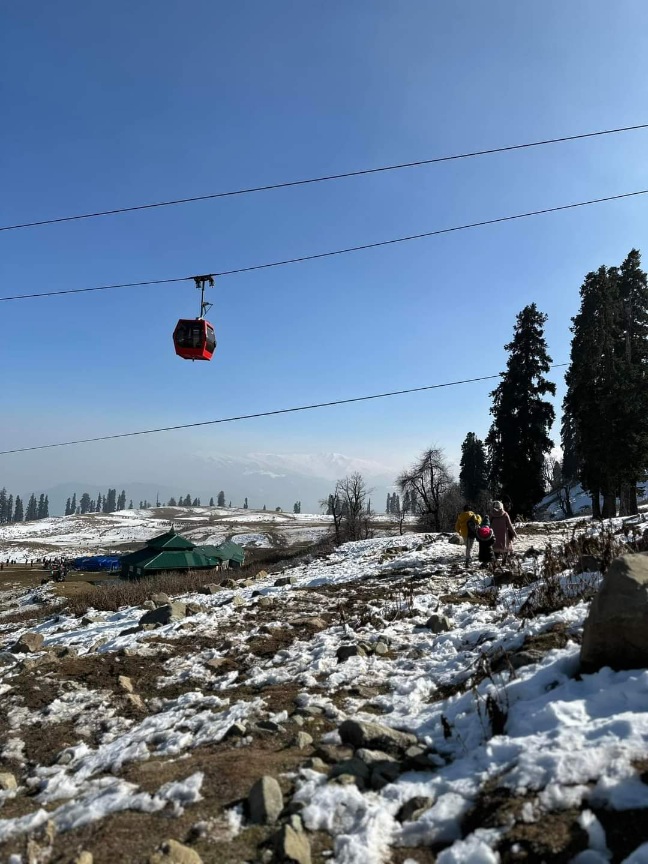
Srinagar, Jan 7: New year’s eve in Kashmir is normally a time when big snows fill its mountains and glaciers are replenished. New Year’s eve is also a time when locals and tourists throng resorts like Gulmarg, Pahalgam, Yusmarg and Sonamarg to enjoy skiing and their magnificent snow charm.
But this year, most of these resorts and Himalayan and Pirpanjal mountains across J&K have little or no snow. As weather is likely to remain dry across Kashmir until 20th January, at least, the crucial time for snow accumulation and glacier formation in the mountains may well be over. If January month passes without snow, 2024 may be tough for farming, tourism and drinking water needs.
While spring may bring considerable precipitation, fewer and scant glaciers may not be able to feed rivers and streams for irrigation water throughout the year.
The question being asked today all around is this: is this snowlessness normal or a cause for worry?
2024 starts with disturbing data from across the globe, suggesting average temperatures are unusually high in most parts of the world.
This winter, unseasonably warmer temperatures and little snow are not only being experienced across J&K but other Himalayan states like Himachal Pradesh and Uttarakand too.
Throughout this winter, so far, Gulmarg, Sonamarg, Pahalgam and Yusmarg have seen erratic snowfall, far below the average. The few flurries that did fall quickly melted away, leaving behind barren slopes and dashed hopes.
Situation in Himachal Pradesh
This New Year eve recorded a 50-60 per cent occupancy in Shimla’s hotels and guest houses, which, according to the state’s Tourism Department, is “the lowest in the last 40 years”. According to the Indian Express, the hotel and allied industries were pinning hopes on a ‘white New Year’ but the state continues to be dry.
The global situation
The Washington Post newspaper reported on Dec 22 that snow cover in the United States and other parts of North America is at its lowest extent on record for the time of year — in many cases melted away by record-warm weather.
Warmer-than-normal weather is expected to prevail not only in most of North America but also in Europe and Asia, much as it has throughout 2023 — the hottest year on record for the planet.
Potential impact on the future of skiing
A recent study published in Nature Climate Change journal, that Ziraat Times analysed, paints a grim picture, predicting that snow shortages in Europe’s mountains will worsen significantly by the end of the century. Even this past winter, the Alps and Rockies groaned under a thin snowpack, forcing resort closures and leaving skiers high and dry.
Half of the world’s ski resorts are in Europe, where they generate about $30 billion per year. A third of the continent’s 2,234 resorts would be highly vulnerable to snow scarcity in the coming years, journal Nature Climate Change reported.
The study also looked at how resorts across Europe — from the British Isles to Turkey, and from Scandinavia to the Mediterranean basin — would be affected by different levels of global heating: 1.5C, 2C, 3C and 4C.
If the world warms 3C above mid-19th century levels and without artificial snow, 100 percent of ski resorts would face a very high risk of insufficient snow supply — every other year, on average — in the German and Austrian Alps, and in Turkey, the study found.
The corresponding figure for the Swiss Alps is 87 percent, 70 percent in the Nordic Mountains, and 91 percent in the Carpathian Mountains.
If the rise in temperatures is held to 1.5C, the rate of “very high risk” is only 4, 5 and 7 percent in the Swiss, French and Austrian Alps, respectively, rising to 20 percent in the German Alps, and 48 percent in the Nordic Mountains.
Pertinently, there has been no such study for the future of skiing in Kashmir’s key ski resort of Gulmarg and other potential resorts like Yusmarg, Pahalgam and Sonamarg.
Why analysing impact of climate change on Kashmir’s tourism and skiing is important
The imperative to undertake serious research into Kashmir’s skiing future may not just be about preserving a sport; it’s about protecting the fragile ecosystem and the communities that depend on it.
“As we enter 2024, the snowless slopes of Gulmarg and Pahalgam serve as a stark warning. They are a chilling reminder of the impact of climate change and the urgent need for action. Let us hope that this New Year’s Eve washout will be a wake-up call, not just for Kashmir, but for the entire country”, said Naveen Chandra, a skiing enthusiast who has been skiing in Gulmarg for about 20 years.
Potential impact on tourism
The impact of snowlessness is not just confined to skiing thrill-seekers. Tourism-dependent communities nestled in Himalayan mountain ranges face serious livelihood challenges. In Kashmir, for instance, where winter tourism is a lifeline for many, erratic snowfall patterns and warmer temperatures, coupled with high urbanisation, could make the place less attractive for tourism in the years to come.
“Some travel agents and hotels are already reporting booking cancellations. It is all about timing. Most tourists usually plan their holidays based on their time availability and make bookings in advance. It is same for skiing – is there is no snow skieers simply cancek their visits”, said Imran Nazir Mir, a travel agent.
Looking ahead
While experts agree that this winter’s snowlessness is a rare phenomenon due to global factors, the overall climate change trends are not encouraging.
“What J&K needs at the policy level and at private business association levels is to invest in research on future scenario building and preparedness. Many ski resorts globally have been taken by surprise and have closed due to less or snow and high maintenance costs. Kashmir will have to plan. Inaction and pinning hopes on luck would not do”, sums up Sidhra Sheikh, who studies economics at Delhi Univeristy.



